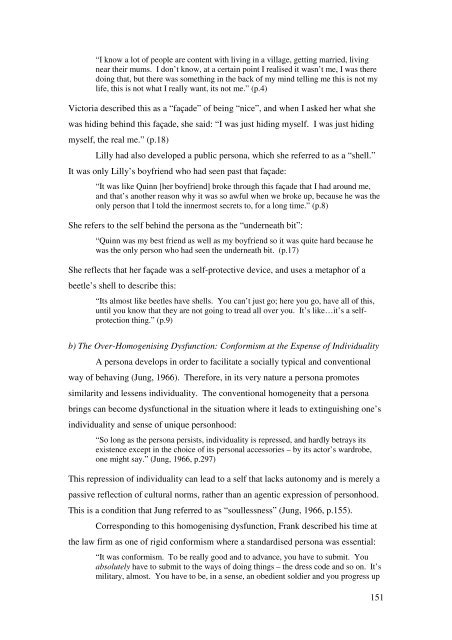DEVELOPMENTAL CRISIS IN EARLY ADULTHOOD: A ...
DEVELOPMENTAL CRISIS IN EARLY ADULTHOOD: A ...
DEVELOPMENTAL CRISIS IN EARLY ADULTHOOD: A ...
You also want an ePaper? Increase the reach of your titles
YUMPU automatically turns print PDFs into web optimized ePapers that Google loves.
“I know a lot of people are content with living in a village, getting married, living<br />
near their mums. I don’t know, at a certain point I realised it wasn’t me, I was there<br />
doing that, but there was something in the back of my mind telling me this is not my<br />
life, this is not what I really want, its not me.” (p.4)<br />
Victoria described this as a “façade” of being “nice”, and when I asked her what she<br />
was hiding behind this façade, she said: “I was just hiding myself. I was just hiding<br />
myself, the real me.” (p.18)<br />
Lilly had also developed a public persona, which she referred to as a “shell.”<br />
It was only Lilly’s boyfriend who had seen past that façade:<br />
“It was like Quinn [her boyfriend] broke through this façade that I had around me,<br />
and that’s another reason why it was so awful when we broke up, because he was the<br />
only person that I told the innermost secrets to, for a long time.” (p.8)<br />
She refers to the self behind the persona as the “underneath bit”:<br />
“Quinn was my best friend as well as my boyfriend so it was quite hard because he<br />
was the only person who had seen the underneath bit. (p.17)<br />
She reflects that her façade was a self-protective device, and uses a metaphor of a<br />
beetle’s shell to describe this:<br />
“Its almost like beetles have shells. You can’t just go; here you go, have all of this,<br />
until you know that they are not going to tread all over you. It’s like…it’s a selfprotection<br />
thing.” (p.9)<br />
b) The Over-Homogenising Dysfunction: Conformism at the Expense of Individuality<br />
A persona develops in order to facilitate a socially typical and conventional<br />
way of behaving (Jung, 1966). Therefore, in its very nature a persona promotes<br />
similarity and lessens individuality. The conventional homogeneity that a persona<br />
brings can become dysfunctional in the situation where it leads to extinguishing one’s<br />
individuality and sense of unique personhood:<br />
“So long as the persona persists, individuality is repressed, and hardly betrays its<br />
existence except in the choice of its personal accessories – by its actor’s wardrobe,<br />
one might say.” (Jung, 1966, p.297)<br />
This repression of individuality can lead to a self that lacks autonomy and is merely a<br />
passive reflection of cultural norms, rather than an agentic expression of personhood.<br />
This is a condition that Jung referred to as “soullessness” (Jung, 1966, p.155).<br />
Corresponding to this homogenising dysfunction, Frank described his time at<br />
the law firm as one of rigid conformism where a standardised persona was essential:<br />
“It was conformism. To be really good and to advance, you have to submit. You<br />
absolutely have to submit to the ways of doing things – the dress code and so on. It’s<br />
military, almost. You have to be, in a sense, an obedient soldier and you progress up<br />
151
















